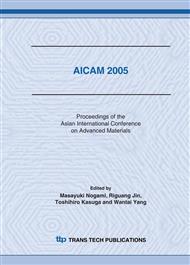p.547
p.551
p.555
p.559
p.563
p.567
p.571
p.575
p.579
Dispersibility and Charge Property of Different Surface Modified Titanium Dioxide as Electrophoretic Particles
Abstract:
To prepare stable electrophoretic ink (E Ink) contains titanium dioxide particles, oil soluble red, dispersant and tetrachloroethylene (TCE), the modification of organic and inorganic material onto the particle surface was investigated. Modified particles were characterized by measurement of X-ray photoelectron spectroscopy (XPS) and Fourier transform infrared spectroscopy (FT-IR) to confirm the composites and structures. The electrophoretic properties of sample in TCE were investigated by static sedimentation experiment and electrophoresis instrument. The type of inorganic and organic materials used for the surface modification influence dispersibility and charge property of particles. On the whole, organic modified particles especially modified by anionic surfactant show better properties. The process conditions were investigated in detail using SDBS as the modifier. The dispersibility and charge property have significantly improved in optimized modifying condition that the proportion of surfactant is 15%, pH is 6 and reaction time is 1 hour which means SDBS modified TiO2 is suitable for electrophoretic particles.
Info:
Periodical:
Pages:
563-566
Citation:
Online since:
February 2006
Authors:
Keywords:
Price:
Сopyright:
© 2006 Trans Tech Publications Ltd. All Rights Reserved
Share:
Citation:


